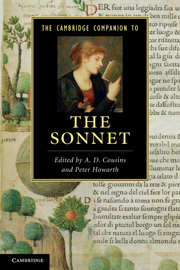Book contents
- Frontmatter
- Introduction
- 1 Contemporary poets and the sonnet
- 2 The sonnet and the lyric mode
- 3 The sonnet, subjectivity and gender
- 4 The English sonnet in manuscript, print and mass media
- 5 European beginnings and transmissions
- 6 Desire, discontent, parody
- 7 Shakespeare’s Sonnets
- 8 Sacred desire, forms of belief
- 9 Survival and change: the sonnet from Milton to the Romantics
- 10 The Romantic sonnet
- 11 The Victorian sonnet
- 12 The modern sonnet
- 13 The contemporary sonnet
- Further reading
- Index
5 - European beginnings and transmissions
Dante, Petrarch and the sonnet sequence
Published online by Cambridge University Press: 28 May 2011
- Frontmatter
- Introduction
- 1 Contemporary poets and the sonnet
- 2 The sonnet and the lyric mode
- 3 The sonnet, subjectivity and gender
- 4 The English sonnet in manuscript, print and mass media
- 5 European beginnings and transmissions
- 6 Desire, discontent, parody
- 7 Shakespeare’s Sonnets
- 8 Sacred desire, forms of belief
- 9 Survival and change: the sonnet from Milton to the Romantics
- 10 The Romantic sonnet
- 11 The Victorian sonnet
- 12 The modern sonnet
- 13 The contemporary sonnet
- Further reading
- Index
Summary
Within the relatively short span of 100 years, southern Italian poets developed the enduring structural properties of sonnet form, northern Italian poets appropriated their invention and expanded its range, and two particular poets with vastly different outlooks and agendas – Dante and Petrarch – exploited its potentials with a lasting impact upon western literature. During these years, the conventional topics addressed by the sonnet form expanded from guileful entreaties of sexual seduction to more complex expressions of tangled erotic yearning, tumultuous sexual impulse and exalted amatory devotion, in associated ways laden with statements of religious conversion, philosophical conviction, political sentiment and even scientific insight. With so many possibilities at hand, the sonnet form carried within it seeds of experiment among poets old and young, male and female, amateur and professional. My chapter will explore the sonnet’s early development from its invention in the thirteenth century to its dissemination throughout Europe in the sixteenth century. It will emphasize the sonnet’s propensity for expressing self-awareness; for affirming local, communal and emergently national sentiment; and for enabling poets to chart a career path that intersects with public as well as private ambitions.
- Type
- Chapter
- Information
- The Cambridge Companion to the Sonnet , pp. 84 - 104Publisher: Cambridge University PressPrint publication year: 2011
- 3
- Cited by

